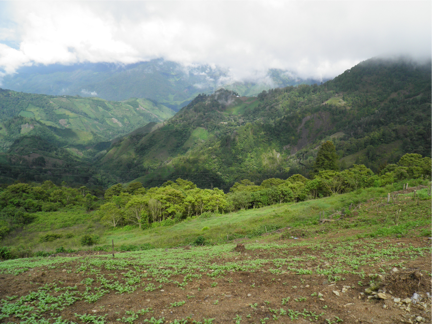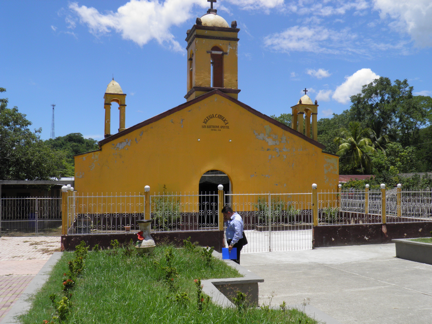This blog is different from many of the others we have shared with you. Usually we share our adventures in hopes of encouraging you to visit a place and to share our experiences there. This time, we’d like to share an adventure in a place that we don’t exactly recommend you visit…
Kees retired from his position as manager of Parks & Recreation, followed by a stint as Senior Manager of the island in Canada where we live. But there’s no rest for the wicked. It wasn’t long before CESO (Canadian Executive Service Organization) invited him to go to Honduras. CESO works with retired professionals who can share their skills with those in developing countries. The San Pedro de Sula Valley, in the north western part of the country, wanted to host him for three weeks, to assist with trail development and eco-tourism opportunities in hopes of boosting their tourism industry.
Honduras has just over 9 million people. Kees wasn’t quite sure about traveling to Honduras. Every government travel website he checked - whether it was Canadian, US, British or Dutch - warned against travel to and in Honduras. As a matter of fact one of the sites stated that the city of San Pedro de Sula, where he would be going, was the murder capital of the world. Who would want to go there, either to help them or as tourist? Kees is always very cautious about safety while traveling so Honduras presented lots of food for thought. But, after checking with people who had been on a CESO assignment in Honduras and learning that they had not encountered any problems, he decided to take the chance and go. But I, as his wife, was advised not to come along!
San Pedro de Sula
There is only a one hour time difference between Canada’s west coast and this small country in Central America. As soon as he landed in San Pedro de Sula, after an 8 hour flight via Mexico City from Vancouver, Kees noticed how similar the city of one million looked to cities in SE Asia, like Vientiane. Or to African towns like Lusaka.
Garbage was strewn everywhere. There were many old buildings, but also several brand new hotels and businesses. When he checked in at the hotel, he was warned not to go outside after dark, that was too dangerous. During the day it was OK to walk around in the neighbourhood, but not after dark. On several occasions Kees walked to a large shopping center, about 15 minutes from the hotel. By the time he walked those 15 minutes, sweat was pouring down his back. The temperatures were well into the 30’s during the day and air conditioning is a must, but also a luxury, here. Often in the late afternoon or early evening, tremendous thunderstorms broke loose with heavy thunder and lighting strikes. In no time streets were inundated with water and cars drove through 2” to 6” of water. But soon after the rain stopped, the elaborate drainage system took care of the water and within a few hours the streets were dry again.
In Kees’ own words: As part of the work I was asked to do here, I was driven, over the course of my several weeks here, to about ten outlying communities around SPS in the valley. This also included visits to one of the national parks.
Several of the other outlying communities are too dangerous to go, just like one particular road up to the National Park had to be avoided. I found the surrounding area quite beautiful. There is lots of green forest, lush banana and coffee plantations. The roads are mostly in good shape, however some road sections to smaller villages are atrocious and it takes hours to drive around potholes at 10 km per hour.
Poverty abounds in the countryside. Some websites identify Honduras as one of the most impoverished countries in Central America. Unemployment is roughly at 27-28% and several of the outlying communities here appear to be half empty. When I asked about that, I was told that many people try to move to North America and end up as illegal residents, often being deported back again.
There is a Pizza Hut, a McDonald’s, Wendy’s and even a Subway near my hotel. When I asked one of the servers, who spoke reasonably good English, where he had learned that he said ”New York”. He had spent 6 years there before he got deported. Unfortunately many Central American gangs are made up of deported LA gang members. Especially El Salvador is notorious for having drug gangs. The Honduras government has worked hard, during the last few years, to change that and is making progress. The GDP also has gone up (7% growth) and a lot of new construction on roads and buildings is evident.
Security is still a major problem. At night a security guard is stationed in front of the hotel. In the shopping centre, dozens of armed guards walk around. Every bank has an armed guard at the door. I was warned against using public transportation since it is not safe for foreigners. Not exactly an encouraging situation for tourists…
The local people, however, are very friendly and helpful. Few speak English. At times, my volunteer work here was quite challenging because I don’t speak much Spanish and, as a result, missed much of the discussion that took place around me as I met with mayors and town council members eager to improve tourism. One interesting thing I noticed is that very few people smoke. However I also noticed that many people are overweight. That may be because going for a jog or even an extended walk is close to impossible in this hot, humid environment. And not many people can afford a membership to the few indoor fitness centres.
Coffee bush
The primary purpose of my assignment was to look for opportunities for trail development. So after seeing some of the poor conditions of trails I put together a manual for trail planning and development. The secondary purpose of my trip was to look for eco-tourism opportunities. I found quite a few. I think it would be interesting for a north American tourist to be able to visit a banana plantation and packing facility, or a coffee plantation. Have you ever seen a cacao plantation? I never knew how cacao grew, and it’s fascinating to learn how it is grown and turned into chocolate bars.
In summary: Honduras was an interesting and unique trip, an eye opener to the poverty and natural abundance of Central America. I would not (yet) recommend this country as a tourist destination because of its security situation. However, I am impressed with its natural beauty. If the government manages to get the drug trade and subsequent murder rate under control and improves the road system, this country can become a major tourist attraction not unlike Costa Rica.
RESOURCES:
https://www.honduras.travel/en/
https://www.ceso-saco.com/







